Temporal and Spatial Variation of Land Use and Vegetation in the Three–North Shelter Forest Program Area from 2000 to 2020
Abstract
1. Introduction
2. Materials and Methods
2.1. Research Area
2.2. Data
2.2.1. Land Use and Land Cover
2.2.2. Vegetation Information Data
2.2.3. Meteorological Data
2.3. Methods
2.3.1. Land Use Change Mapping
- (1)
- No change. It denotes that the type of land remains unchanged from 2000 to 2020.
- (2)
- Previous change. It refers to the type of land transfer that occurred from 2000 to 2010.
- (3)
- Later change. It refers to the type of land transfer that occurred from 2010 to 2020.
- (4)
- Repeated change. It refers to the type of land that transferred only in 2010 and remained consistent in 2000 and 2020.
- (5)
- Continuous change. It denotes that the type of land was different in 2000, 2010 and 2020.
2.3.2. Vegetation Coverage Extraction
2.3.3. Linear Regression Analysis
2.3.4. Sen’s Trend Degree, M–K Significance Test
2.3.5. Correlation Analysis
3. Results
3.1. Change of Land Use and Land Cover in the TNSFPA from 2001 to 2020
3.2. Change of Vegetation Coverage in the TNSFPA from 2000 to 2020
3.3. Change of Vegetation Productivity in the TNSFPA from 2000 to 2020
4. Discussions
4.1. Climate Drivers of Vegetation Change
4.2. Effects of LUCC on Vegetation Coverage and Productivity
4.3. Comparison of Current Research
5. Conclusions
- (1)
- The percentage of unchanged land was 90.05% in the TNSFPA from 2001 to 2020. Except for the increase in the area of cultivated land and constructive land, all other land use types showed a decreasing trend. The late change (58.06%) was the main change pattern, followed by the early change (28.94%) and repeated change (10.62%). The change of land use showed the characteristics of cultivated land and forest were mainly transformed into grassland, whereas grassland was mainly transformed into cultivated land and barren, which fully reflected the national policy of “returning farmland to forest land or grassland” and the current situation of grassland reclamation and degradation.
- (2)
- From 2000 to 2020, vegetation coverage in the study area generally presented a spatial distribution pattern of high coverage in the east and low coverage in the west, and the regional interannual fluctuation of high coverage was small. A total of 90.31% of the area showed an increasing trend (0.41%·a−1); 62.30% of the area showed a significant increasing trend, and the change rates in northeastern, northern, and northwestern China were 0.51%·a−1, 0.54%·a−1 and 0.37%·a−1, respectively. The trend of vegetation coverage in different seasons of the TNSFPA were all dominated by significant increase from 2000 to 2020.
- (3)
- From 2000 to 2020, the distribution space of vegetation productivity in the TNSFPA was basically the same as the coverage, and the interannual fluctuation in areas with low productivity was small. A total of 51.66% of the area showed an increasing trend (3.41 gC·m−2·a−1), mainly in the basic stable state and significantly increased state. The change rates in northeastern, northern, and northwestern China were 7.34 gC·m−2·a−1, 6.72 gC·m−2·a−1 and 2.10 gC·m−2·a−1, respectively. The trend of vegetation productivity in different seasons of the TNSFPA were all dominated by basic stability from 2000 to 2020.
- (4)
- The vegetation coverage and productivity in the TNSFPA were positively correlated with climate factors, and the correlation of precipitation was significantly higher than that of temperature. The proportion of areas with positive correlation between vegetation coverage and temperature and precipitation was 64.06% and 86.58%, respectively. The proportion of areas with a positive correlation between vegetation productivity and temperature and precipitation was 40.70% and 53.51%, respectively. The climatic factor restricting vegetation growth in the study area was mainly precipitation. The ecological protection and restoration activities of the TNSFPA have accelerated the restoration of the vegetation ecosystem. The rapid growth of population has led to the acceleration of urbanization. The intensification of the interaction of humans and land has led to the reclamation and development of barren, which had a great impact on the small–scale vegetation ecosystem.
Author Contributions
Funding
Institutional Review Board Statement
Informed Consent Statement
Data Availability Statement
Acknowledgments
Conflicts of Interest
References
- Mooney, H.A.; Duraiappah, A.; Larigauderie, A. Evolution of natural and social science interactions in global change research programs. Proc. Natl. Acad. Sci. USA 2013, 110, 3665–3672. [Google Scholar] [CrossRef] [PubMed]
- IPCC. Climate Change 2021: The Physical Science Basis Summary for Policymakers; Cambridge University Press: London, UK, 2021. [Google Scholar]
- Sterling, S.; Ducharne, A.; Polcher, J. The impact of global land–cover change on the terrestrial water cycle. Nat. Clim. Chang. 2013, 3, 385–390. [Google Scholar] [CrossRef]
- Mishra, A.; Humpenöder, F.; Churkina, G.; Reyer, C.P.O.; Beier, F.; Bodirsky, B.L.; Schellnhuber, H.J.; Campen, H.L.; Popp, A. Land use change and carbon emissions of a transformation to timber cities. Nat. Commun. 2022, 13, 4889–4900. [Google Scholar] [CrossRef] [PubMed]
- Meyfroidt, P.; Lambin, E.F.; Erb, K.; Hertel, T.W. Globalization of land use: Distant drivers of land change and geographic displacement of land use. Curr. Opin. Environ. Sust. 2013, 5, 438–444. [Google Scholar] [CrossRef]
- Liu, J.Y.; Kuang, W.H.; Zhang, Z.X.; Xu, X.L.; Qin, Y.W.; Ning, J.; Zhou, W.C.; Zhang, S.W.; Li, R.D.; Yan, C.Z.; et al. Spatiotemporal characteristics, patterns and causes of land use changes in China since the late 1980s. Acta Geogr. Sin. 2014, 69, 3–14. [Google Scholar] [CrossRef]
- Parmesan, C.; Yohe, G. A globally coherent fingerprint of climate change impacts across natural systems. Nature 2003, 421, 37–42. [Google Scholar] [CrossRef] [PubMed]
- Chen, X.Q.; Wang, H. Spatial and temporal variations of vegetation belts and vegetation cover degrees in Inner Mongolia from 1982 to 2003. Acta Geogr. Sin. 2009, 64, 84–94. [Google Scholar] [CrossRef]
- Carmichael, M.J.; Bernhardt, E.S.; Bruer, S.L.; Smith, W.K. The role of vegetation in methane flux to the atmosphere: Should vegetation be included as a distinct category in the global methane budget? Biogeochemistry 2014, 119, 1–24. [Google Scholar] [CrossRef]
- Grahn, P.; Stigdotter, U.A. Landscape planning and stress. Urban For. Urban Green. 2003, 2, 1–18. [Google Scholar] [CrossRef]
- Ma, M.G.; Wang, J.; Wang, X.M. Advance in the inter-annual variability of vegetation and its relation to climate based on remote sensing. J. Remote Sens. 2006, 10, 421–431. [Google Scholar] [CrossRef]
- Zhang, X.W.; Wu, B.F.; Ling, F.; Zeng, Y.; Yan, N.N.; Yuan, C. Identification of priority areas for controlling soil erosion. Catena 2010, 83, 76–86. [Google Scholar] [CrossRef]
- Qiu, H.J.; Cao, M.M. Spatial and temporal variations in vegetation cover in China based on SPOT vegetation data. Res. Sci. 2011, 33, 145–150. [Google Scholar]
- Zhang, X.Z.; Zheng, J.Y.; He, F.N.; Dai, J.H. Regional differences in the process of vegetation cover change in Eastern China from 1982 to 2006. J. Nat. Res. 2013, 28, 28–37. [Google Scholar] [CrossRef]
- Wang, J.; Wang, K.L.; Zhang, M.Y.; Duan, Y.F. Temporal–spatial variation in NDVI and drivers in hilly terrain of southern China. Res. Sci. 2014, 36, 1712–1723. [Google Scholar]
- Lu, Y.H.; Coops, N.C.; Hermosilla, T. Estimating urban vegetation fraction across 25 cities in pan-Pacific using Landsat time series data. ISPRS J. Photogramm. 2017, 126, 11–23. [Google Scholar] [CrossRef]
- Roerink, G.J.; Menenti, M.; Soepboer, W.; Su, Z. Assessment of climate impact on vegetation dynamics by using remote sensing. Phys. Chem. Earth 2003, 28, 103–109. [Google Scholar] [CrossRef]
- Zhang, L.; Ding, M.J.; Zhang, H.M.; Wen, C. Spatiotemporal variation of the vegetation coverage in Yangtze river basin during 1982-2015. J. Nat. Res. 2018, 33, 2084–2097. [Google Scholar] [CrossRef]
- Milesi, C.; Elvidge, C.D.; Nemani, R.R.; Running, S.W. Assessing the impact of urban land development on net primary productivity in the southeastern United States. Remote Sens. Environ. 2003, 86, 401–410. [Google Scholar] [CrossRef]
- Qian, L.X.; Cui, H.S.; Chang, J. Impacts of land use and cover change on land surface temperature in the Zhujiang Delta. Pedosphere 2006, 16, 681–689. [Google Scholar] [CrossRef]
- Pan, P.P.; Yang, G.S.; Su, W.Z. Progress on effects of land use change on land productivity. Prog. Geogr. 2012, 31, 539–550. [Google Scholar] [CrossRef]
- Pan, P.P.; Yang, G.S.; Su, W.Z.; Wang, X.X. Impact of land use change on cultivated land productivity in Taihu lake basin. Sci. Geogr. Sin. 2015, 35, 990–998. [Google Scholar] [CrossRef]
- Dai, E.F.; Wu, S.H. Sustainable land use: Literature review and research progress. Prog. Geogr. 2004, 23, 79–88. [Google Scholar] [CrossRef]
- Fu, L.N.; Chen, X.D.; Leng, Z.H. Urban agglomerations eco–efficiency analysis based on super–efficiency DEA model: Case study of Chang-Zhu-Tan “3+5” urban agglomeration. Chin. Pop. Res. Environ. 2013, 23, 169–175. [Google Scholar] [CrossRef]
- Wang, L.J.; Li, H.; Shi, C. Urban land–use efficiency, spatial spillover, and determinants in China. Acta Geogr. Sin. 2015, 70, 1788–1799. [Google Scholar] [CrossRef]
- Jin, G.; Deng, Z.X.; Zhao, X.D.; Guo, B.S.; Yang, J. Spatio–temporal patterns of urban land use efficiency in the Yangtze River Economic Zone during 2005–2014. Acta Geogr. Sin. 2018, 73, 1242–1252. [Google Scholar] [CrossRef]
- Wang, S.Q.; Xu, J.; Zhou, C.H. The effect of land cover change on carbon cycle: A case study in the estuary of Yellow River Delta. Natl. Remote Sens. Bull. 2001, 5, 142–148. [Google Scholar] [CrossRef]
- Piao, S.L.; Fang, J.Y.; Ciais, P.; Peylin, P.; Huang, Y.; Stich, S.; Wang, T. The carbon balance of terrestrial ecosystems in China. Nature 2009, 458, 1009–1013. [Google Scholar] [CrossRef] [PubMed]
- Fu, C.; Yu, G.R.; Fang, H.J.; Wang, Q.F. Effects of land use and cover change on terrestrial carbon balance of China. Prog. Geogr. 2012, 31, 88–96. [Google Scholar] [CrossRef]
- Jia, K.; Yao, Y.J.; Wei, X.Q.; Gao, S.; Jiang, B.; Zhao, X. A review on fractional vegetation cover estimation using remote sensing. Adv. Earth Sci. 2013, 28, 774–782. [Google Scholar] [CrossRef]
- Wang, Z.; Shi, Q.S.; Wang, T.; Shi, Q.D.; Chang, S.L.; Zhang, L.B. Spatio–temporal characteristics of vegetation cover change in mountain-oasis-desert system of Xinjiang from 1982 to 2006. J. Nat. Res. 2011, 26, 609–618. [Google Scholar] [CrossRef]
- He, B.Z.; Ding, J.L.; Zhang, Z.; Abduwasit, G. Experimental analysis of spatial and temporal dynamics of fractional vegetation cover in Xinjiang. Acta Geogr. Sin. 2016, 71, 1948–1966. [Google Scholar] [CrossRef]
- Zhang, H.; Qu, J.J.; Zhang, K.C. Vegetation cover information extraction technology for Dunhuang Oasis based on remote sensing images. J. Des. Res. 2015, 35, 493–498. [Google Scholar] [CrossRef]
- Zhao, T.; Bai, H.Y.; Deng, C.H.; Meng, Q.; Guo, S.Z.; Qi, Z.G. Topographic differentiation effect on vegetation cover in the Qinling Mountains from 2000 to 2016. Acta Ecol. Sin. 2019, 39, 4499–4509. [Google Scholar] [CrossRef]
- Qi, Y.X.; Zhang, F.; Chen, R.; Wang, Y.S. Vegetation coverage dynamics in northern slope of Tianshan Mountains from 2001 to 2015. Acta Ecol. Sin. 2020, 40, 3677–3687. [Google Scholar] [CrossRef]
- Xiao, T.; Liu, J.Y.; Shao, Q.Q. A simulation on changes in vegetation productivity in “Three River Sources” nature reserve, Qinghai province over past 20 years. J. Geo-Inf. Sci. 2009, 11, 557–565. [Google Scholar] [CrossRef]
- Wu, X.F.; Li, G.X.; Pan, X.P.; Wang, Y.F.; Zhang, S.; Liu, F.G.; Shen, Y.J. Response of vegetation cover to temperature and precipitation in the source region of the Yellow River. Res. Sci. 2015, 37, 512–521. [Google Scholar]
- Zhang, Z.Q.; Liu, H.; Zuo, Q.T.; Yu, J.T.; Li, Y. Spatiotemporal change of fractional vegetation cover in the Yellow River basin during 2000–2019. Res. Sci. 2021, 43, 849–858. [Google Scholar] [CrossRef]
- Wu, Y.; Zeng, Y.; Wu, B.F.; Li, X.S.; Wu, W.B. Retrieval and analysis of vegetation cover in the Three–North Regions of China based on MODIS data. Chin. J. Ecol. 2009, 28, 1712–1718. [Google Scholar]
- Dai, S.P.; Ma, Z.H.; Wang, Q.; Zhang, B.; Zhang, Y.N.; Zou, Y. Dynamic changes in vegetation coverage in the Three–North Shelter Forest Program based on GIMMS AVHRR NDVI. Res. Sci. 2011, 33, 1613–1620. [Google Scholar]
- Zhu, P.; Huang, L.; Xiao, T.; Wang, J.B. Dynamic change of habitats in China’s typical nature reserves on spatial and temporal scales. Acta Geol. Sin. 2018, 73, 92–103. [Google Scholar] [CrossRef]
- Fensholt, R.; Langanke, T.; Rasmussen, K.; Reenberg, A.; Prince, S.D.; Tucker, C.; Scholes, R.J.; Le, Q.B.; Bondeau, A.; Eastman, R.; et al. Greenness in semi-arid areas across the globe 1981-2007: An Earth Observing Satellite based analysis of trends and drivers. Remote Sens. Environ. 2012, 121, 144–158. [Google Scholar] [CrossRef]
- Pang, G.W.; Yang, Q.K.; Wang, C.M.; Shan, L.X.; Wang, B.L. Influence of parameter determination methods of the pixel dichotomy model on the estimation accuracy of fractional vegetation cover by GF–1 PMS data. Geogr. Inf. Sci. 2019, 35, 27–33. [Google Scholar] [CrossRef]
- Puigderfabregas, J. Ecological impacts of global change on drylands and their implications for desertification. Land Degrad. Dev. 1998, 9, 393–406. [Google Scholar] [CrossRef]
- Lioubimtseva, E.; Cole, R.; Adams, J.M.; Kapustin, G. Impacts of climate and land–cover changes in arid lands of Central Asia. J. Arid Environ. 2005, 62, 285–308. [Google Scholar] [CrossRef]
- Dao, R.N. Effects of Climate and Land Use Change on Vegetation NDVI in the Three North Region. Master’s Thesis, Inner Mongolia Normal University, Hohhot, China, 2019. [Google Scholar]
- Zhang, L.X.; Song, Y.Q. Efficiency of the Three-North Forest Shelterbelt Program. Acta Sci. Nat. Univ. Peking 2003, 39, 594–600. [Google Scholar]
- Wang, Q. Study on Dynamic Change of Vegetation Coverage and Response to Climate Change in the Three–North Shelter Forest Program. Master’s Thesis, Northwest Normal University, Lanzhou, China, 2012. [Google Scholar]
- Loveland, T.R.; Belward, A.S. The international geosphere biosphere programme data and information system global land cover data set (DISCover). Acta Astronaut. 1997, 41, 681–689. [Google Scholar] [CrossRef]
- Belward, A.S.; Estes, J.E.; Kline, K.D. The igbp–dis global 1–km land–cover data set discover: A project overview. Photogramm. Eng. Remote Sens. 1999, 65, 1013–1020. [Google Scholar] [CrossRef]
- Sulla-Menashe, D.; Gray, J.M.; Abercrombie, S.P.; Friedl, M.A. Hierarchical mapping of annual global land cover 2001 to present: The modis collection 6 land cover products. Remote Sens. Environ. 2019, 222, 183–194. [Google Scholar] [CrossRef]
- Friedl, M.A.; McIver, D.K.; Hodges, J.; Zhang, X.Y.; Muchoney, D.; Strahler, A.H.; Woodcock, C.E.; Gopal, S.; Schneider, A.; Cooper, A.; et al. Global land cover mapping from MODIS: Algorithms and early results. Remote Sens. Environ. 2002, 83, 287–302. [Google Scholar] [CrossRef]
- Friedl, M.A.; Sulla-Menashe, D.; Tan, B.; Schneider, A.; Ramankutty, N.; Sibley, A.; Huang, X. MODIS Collection 5 global land cover: Algorithm refinements and characterization of new datasets. Remote Sens. Environ. 2010, 114, 168–182. [Google Scholar] [CrossRef]
- Schaaf, C.B.; Gao, F.; Strahler, A.H.; Lucht, W.; Li, X.; Tsang, T.; Strugnell, N.C.; Zhang, X.Y.; Jin, Y.F.; Muller, J.P.; et al. First operational BRDF, albedo nadir reflectance products from MODIS. Remote Sens. Environ. 2002, 83, 135–148. [Google Scholar] [CrossRef]
- Bao, W.D.; Hou, Z.H.; Wu, Q.Y. Research on land use changes based on Geo–informatic tupu–Taking Longkou city of Shandong province as an example. Area Res. Dev. 2007, 26, 80–84. [Google Scholar]
- Wang, S.; Zhang, L.L.; Lin, W.B.; Huang, Q.S.; Song, Y.X.; Ye, M. Study on vegetation coverage and land-use change of Guangdong province based on MODIS-NDVI. Acta Ecol. Sin. 2022, 42, 2149–2163. [Google Scholar] [CrossRef]
- Adams, J.E.; Arkin, G.F. A light interception method for measuring row crop ground cover. Soil. Sci. Soc. Am. J. 1977, 41, 789–792. [Google Scholar] [CrossRef]
- Zhu, L.F. Study on the Spatial-Temporal Variation of Vegetation Coverage and Karst Rocky Desertification Bases on MODIS Data. Ph.D. Thesis, Southwest University, Chongqing, China, 2018. [Google Scholar]
- Holben, B.N. Characteristics of maximum–value composite images from temporal AVHRR data. Int. J. Remote Sens. 1986, 7, 1417–1434. [Google Scholar] [CrossRef]
- Stow, D.; Petersen, A.; Hope, A.; Engstrom, R.; Coulter, L. Greenness trends of Arctic tundra vegetation in the 1990s: Comparison of two NDVI datasets from NOAA AVHRR systems. Int. J. Remote Sens. 2007, 28, 4807–4822. [Google Scholar] [CrossRef]
- Cao, X.J.; Hasbagan, G.; Hu, G.Z.; Gao, Q.Z. Characteristics of grassland degradation in the Qinghai Tibetan Plateau, based on NDVI3g data. Chin. J. Agric. 2019, 40, 86–95. [Google Scholar] [CrossRef]
- Gutman, G.; Ignatov, A. The derivation of the green vegetation fraction from NOAA/AVHRR data for use in numerical weather prediction models. Int. J. Remote Sens. 1998, 19, 1533–1543. [Google Scholar] [CrossRef]
- Carlson, T.N.; Ripley, D.A. On the relation between NDVI, fractional vegetation cover, and leaf area index. Remote Sens. Environ. 1998, 62, 241–252. [Google Scholar] [CrossRef]
- Mu, S.J.; Li, J.L.; Chen, Y.Z.; Gang, C.C.; Zhou, W.; Ju, W.M. Spatial differences of variations of vegetation coverage in Inner Mongolia during 2001–2010. Acta Geogr. Sin. 2012, 67, 1255–1268. [Google Scholar] [CrossRef]
- Stow, D.; Daeschner, S.; Hope, A.; Douglas, D.; Petersen, A.; Myneni, R.; Zhou, L.; Oechel, W. Variability of the seasonally integrated normalized difference vegetation index across the north slope of Alaska in the 1990s. Int. J. Remote Sens. 2003, 24, 1111–1117. [Google Scholar] [CrossRef]
- Wei, F.Y. Regional consensus forecast method with dynamic weighting for summer precipitation over China. J. Appl. Meteorol. Sci. 1999, 4, 402–409. [Google Scholar]
- Xu, J.H. Mathematical Methods in Contemporary Geography; Higher Education Press: Beijing, China, 2017; pp. 133–134. [Google Scholar]
- Yu, X.F.; Zhuang, D.F. Monitoring forest phenophases of North China based on MODIS NDVI data. Res. Sci. 2006, 28, 111–117. [Google Scholar]
- Deng, C.H.; Bai, H.Y.; Ma, X.P.; Zhao, T.; Gao, S.; Huang, X.Y. Spatiotemporal differences in the climatic growing season in the Qinling Mountains of China under the influence of global warming from 1964 to 2015. Theor. Appl. Climatol. 2019, 138, 1899–1911. [Google Scholar] [CrossRef]
- Ji, Y.H.; Zhou, G.S.; Wang, S.D.; Wang, L.X.; Zhou, M.Z. Evolution characteristics and its driving forces analysis of vegetation ecological quality in Qinling Mountains region from 2000 to 2019. Chin. J. Plant Ecol. 2021, 45, 617–625. [Google Scholar] [CrossRef]
- Li, H.W.; Ding, J.H.; Zhang, J.; Yang, Z.N.; Yang, B.; Zhu, Q.A.; Peng, C.H. Effects of Land Cover Changes on Net Primary Productivity in the Terrestrial Ecosystems of China from 2001 to 2012. Land 2020, 9, 480. [Google Scholar] [CrossRef]
- Song, Y.; Ma, M.G. Study on vegetation cover change in Northwest China based on SPOT VEGETATION data. J. Des. Res. 2007, 27, 89–93. [Google Scholar]
- Wu, C.G.; Zhou, Z.X.; Xiao, W.F.; Wang, P.C.; Wang, T.; Huang, Z.J. Dynamic monitoring of vegetation coverage in the Three Gorges Reservoir area based on MODIS–NDVI. Sci. Silvae Sin. 2012, 48, 22–28. [Google Scholar] [CrossRef]
- Beer, C.; Reichstein, M.; Tomelleri, E.; Ciais, P.; Jung, M.; Carvalhais, N.; Rodenbeckm, C.; Arain, M.A.; Baldocchi, D.; Bonan, G.B.; et al. Terrestrial gross carbon dioxide uptake: Global distribution and covariation with climate. Science 2010, 329, 834–838. [Google Scholar] [CrossRef]
- Niu, Z.E.; Yan, H.M.; Chen, J.Q.; Huang, M.; Wang, S.Q. Comparison of crop gross primary productivity estimated with VPM model and MOD17 product in field ecosystem of China. Trans. Chin. Soc. Agric. Eng. 2016, 32, 191–198. [Google Scholar]
- Xu, H.Q. Assessment of ecological change in soil loss area using remote sensing technology. Trans. Chin. Soc. Agric. Eng. 2013, 29, 91–97+294. [Google Scholar]
- Fang, J.Y.; Song, Y.C.; Liu, H.Y.; Piao, S.L. Vegetation climate relationship and its application in the division of vegetation zone in China. Acta Bot. Sin. 2002, 44, 1105–1122. [Google Scholar]
- Sun, Y.L.; Yang, Y.L.; Zhang, L.; Wang, Z.L. The relative roles of climate variations and human activities in vegetation change in North China. Phys. Chem. Earth 2015, 87–88, 67–78. [Google Scholar] [CrossRef]
- Zhang, W.; Wang, L.C.; Xiang, F.F.; Qin, W.M.; Jiang, W.X. Vegetation dynamics and the relations with climate change at multiple time scales in the Yangtze River and Yellow River Basin, China. Ecol. Indic. 2020, 110, 105892–105904. [Google Scholar] [CrossRef]
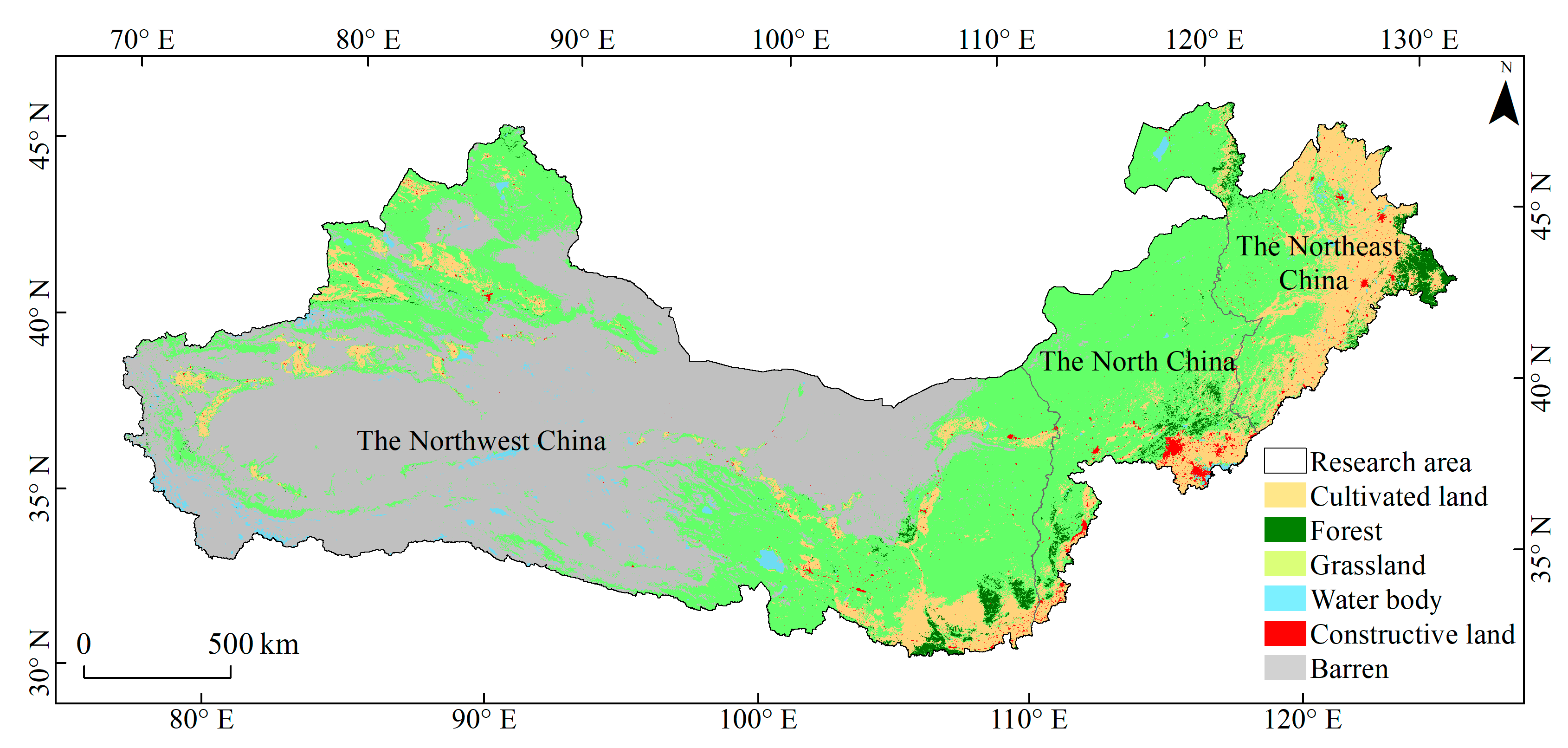
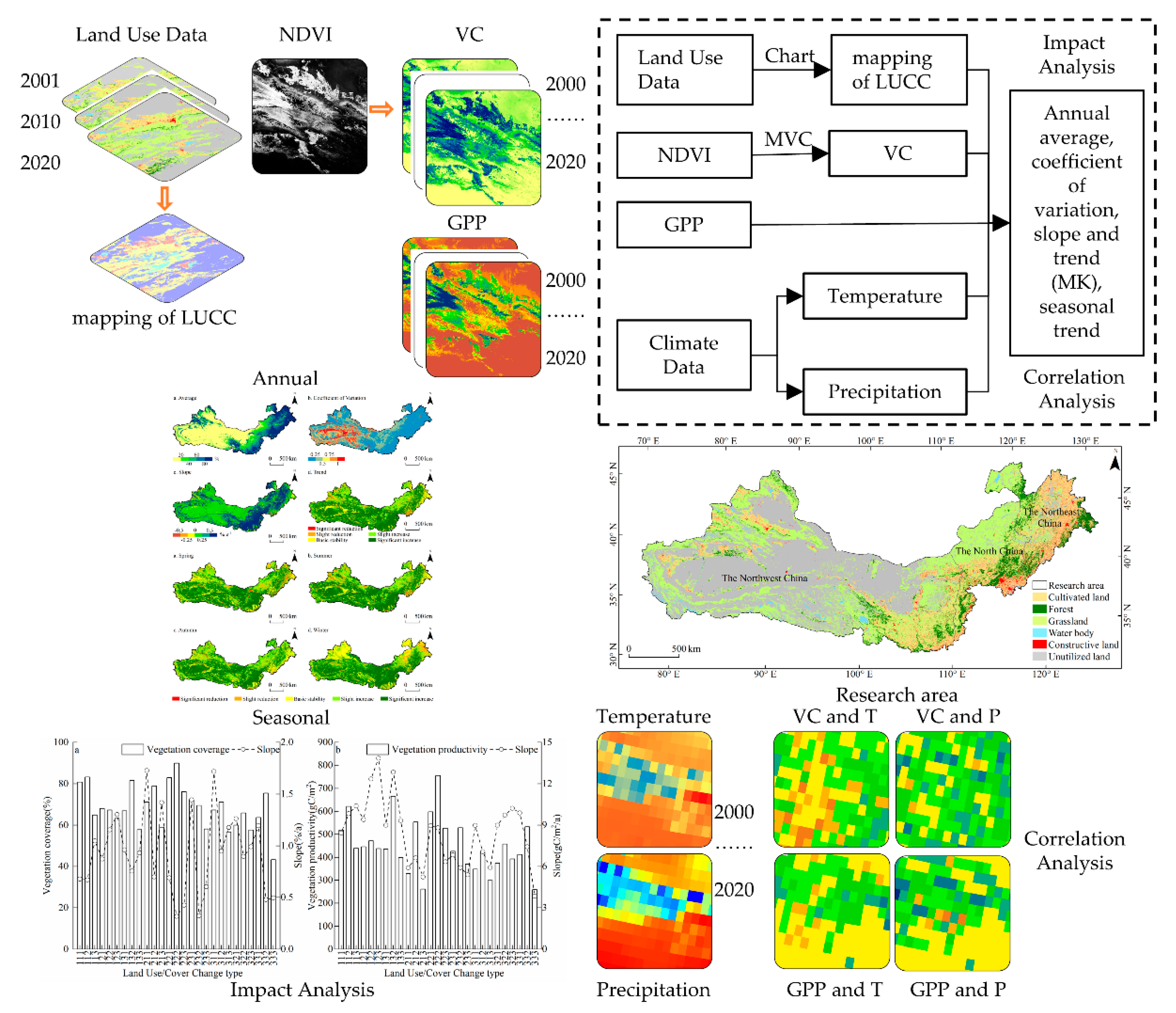



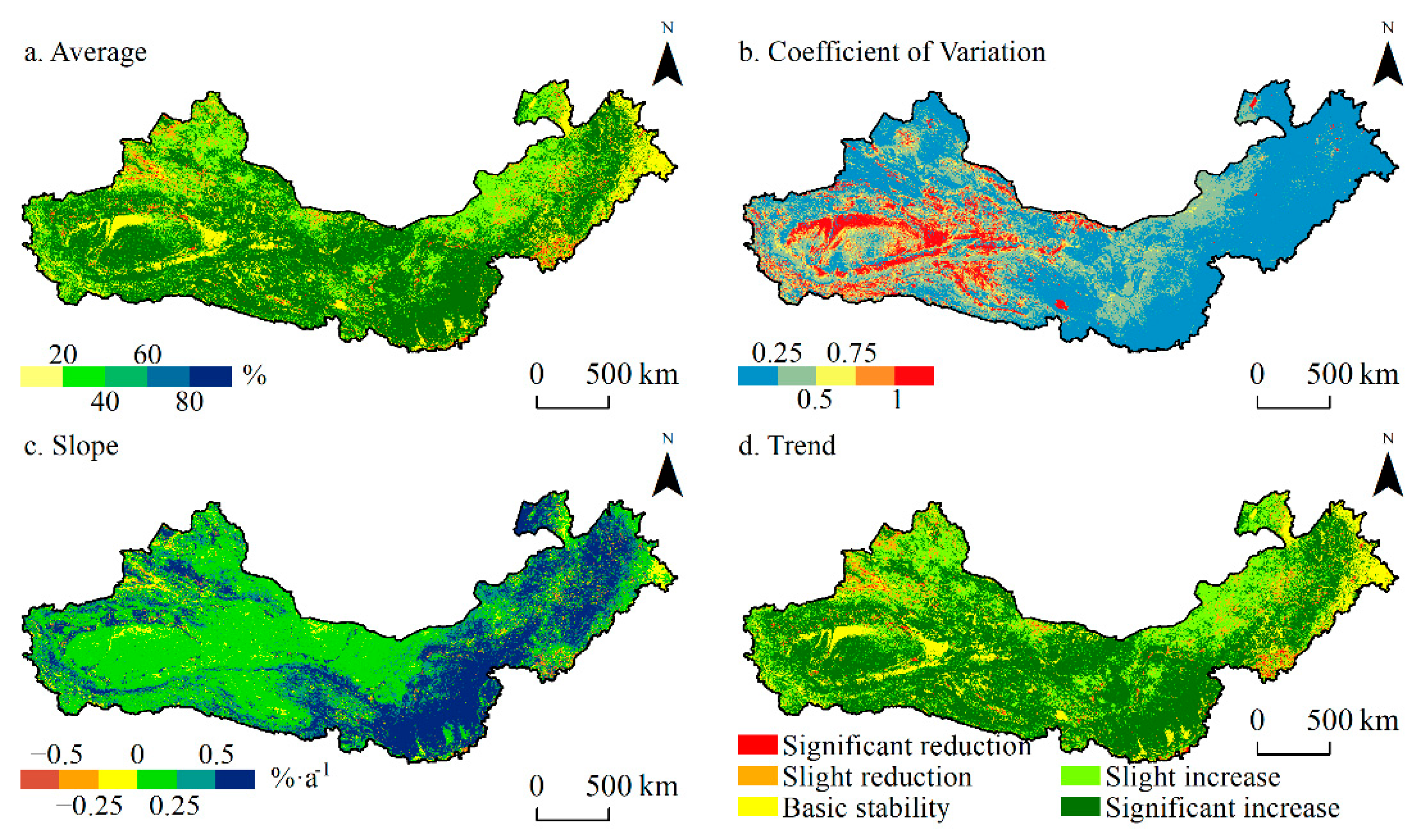
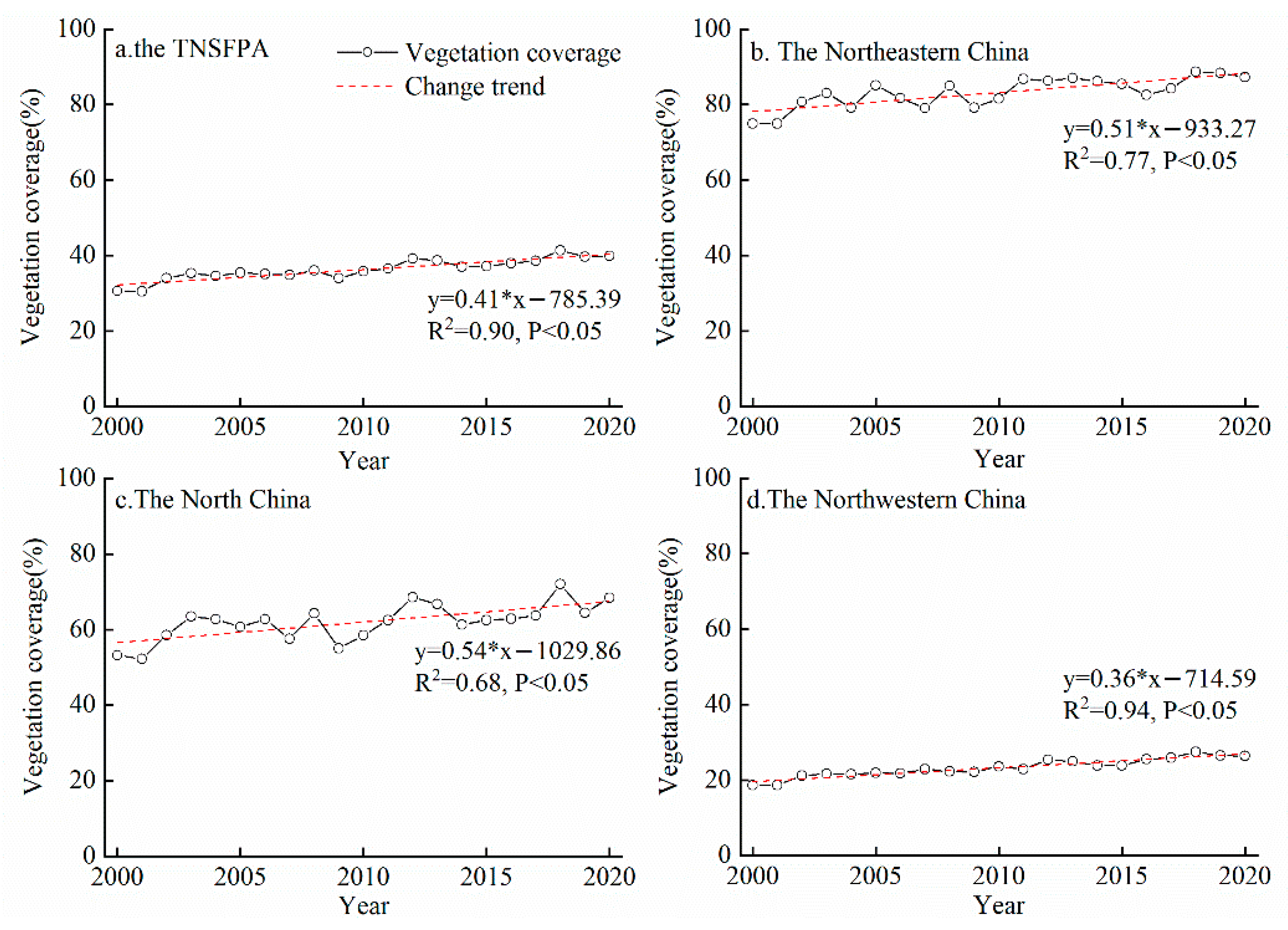
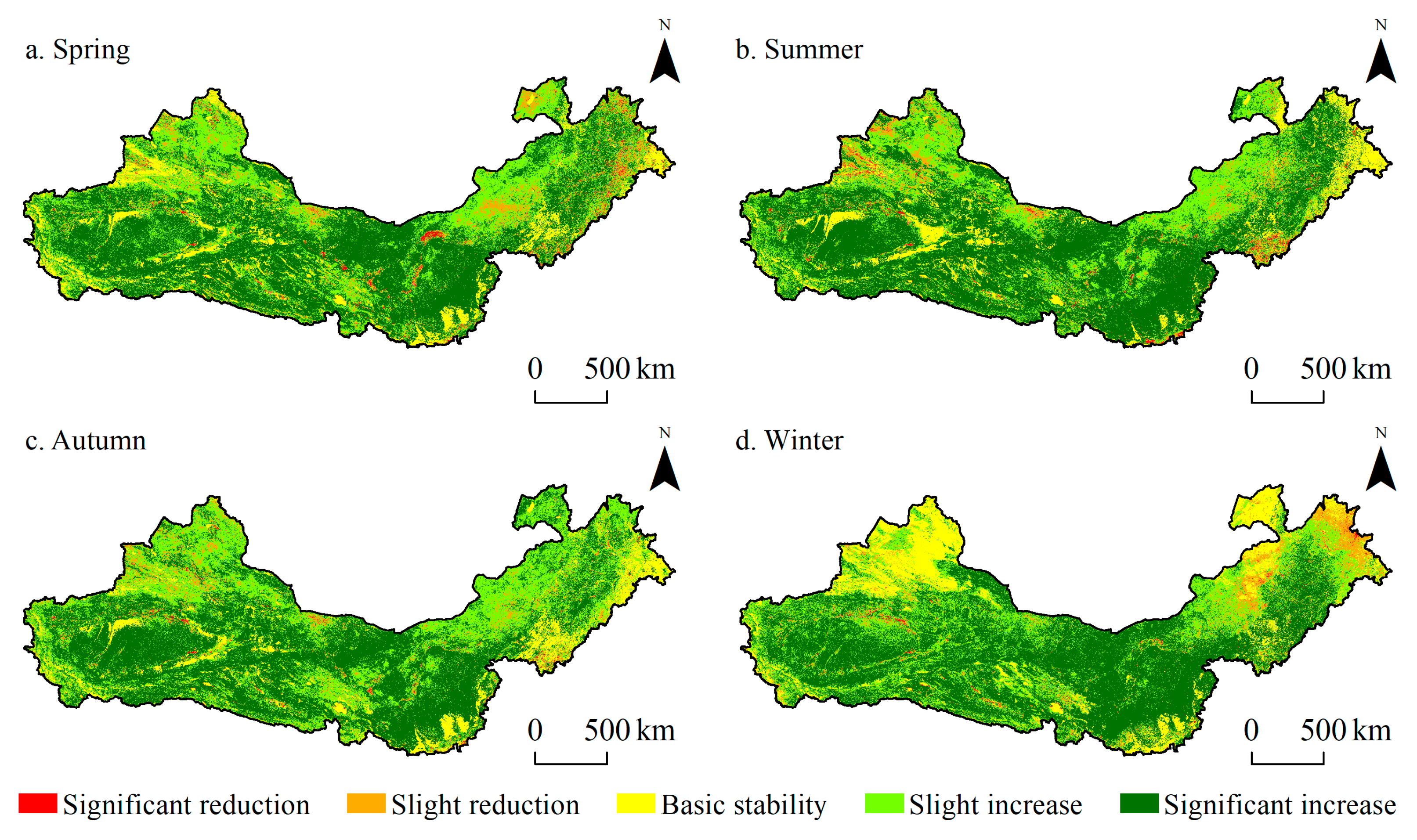

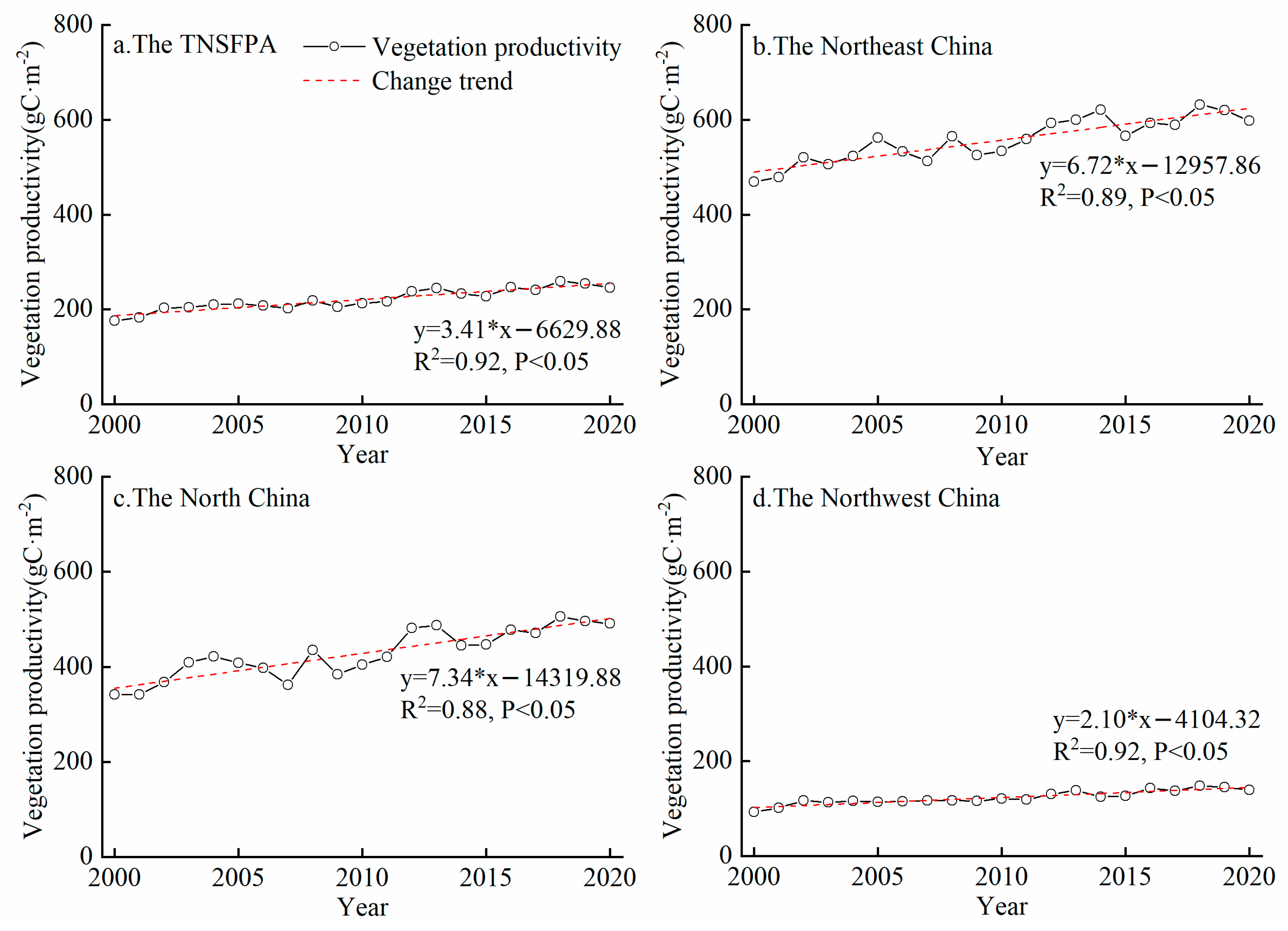
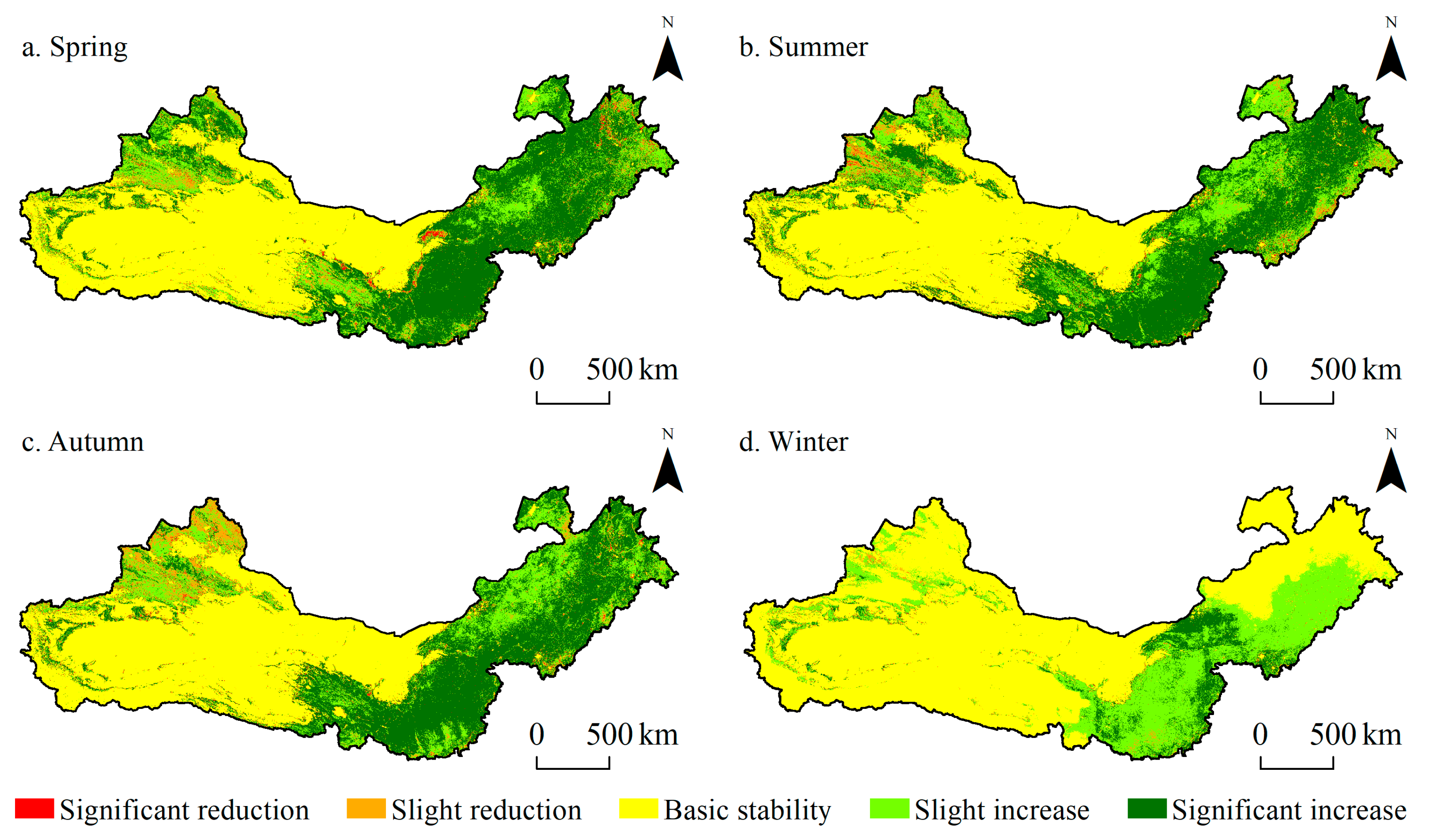
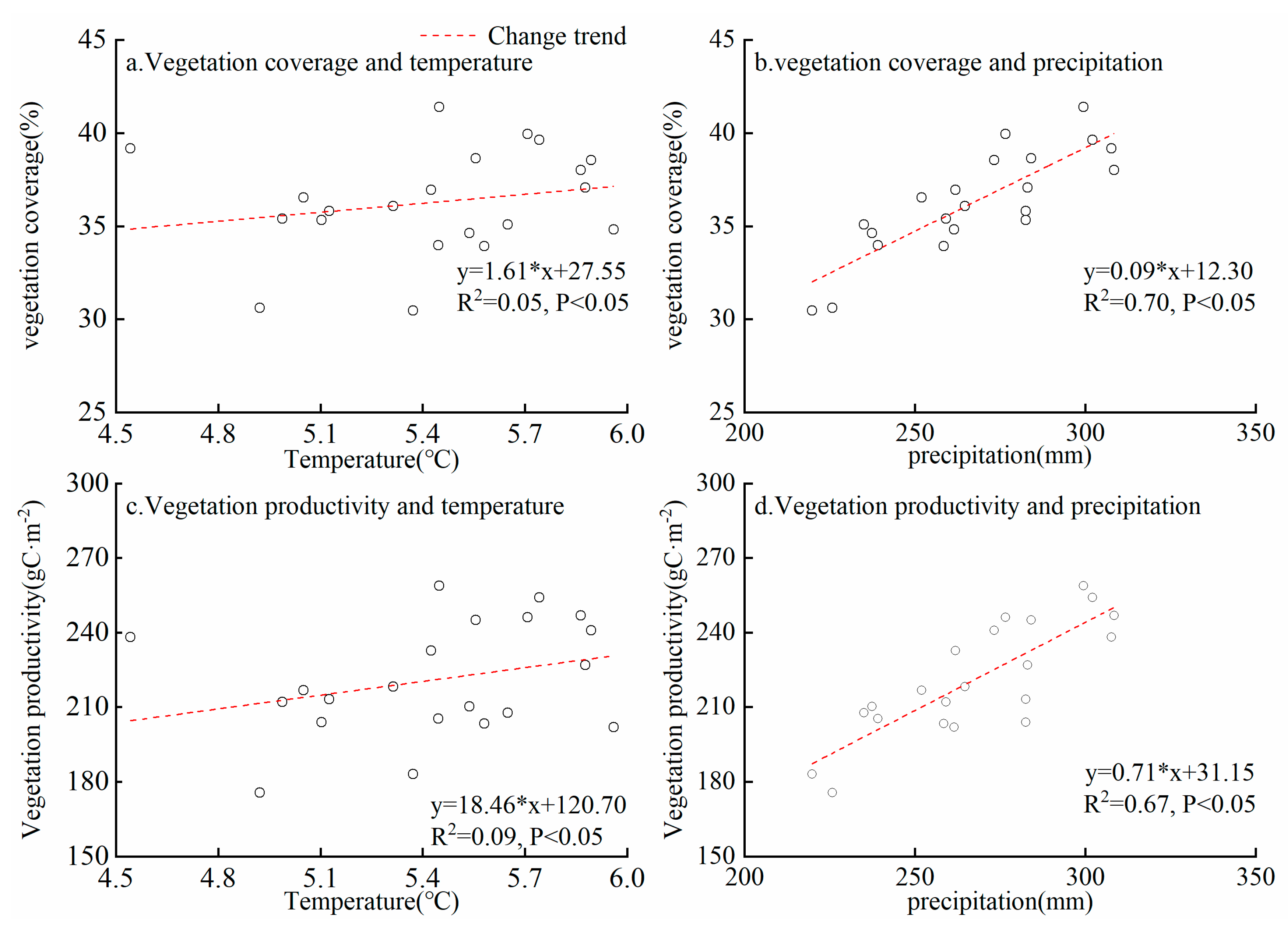
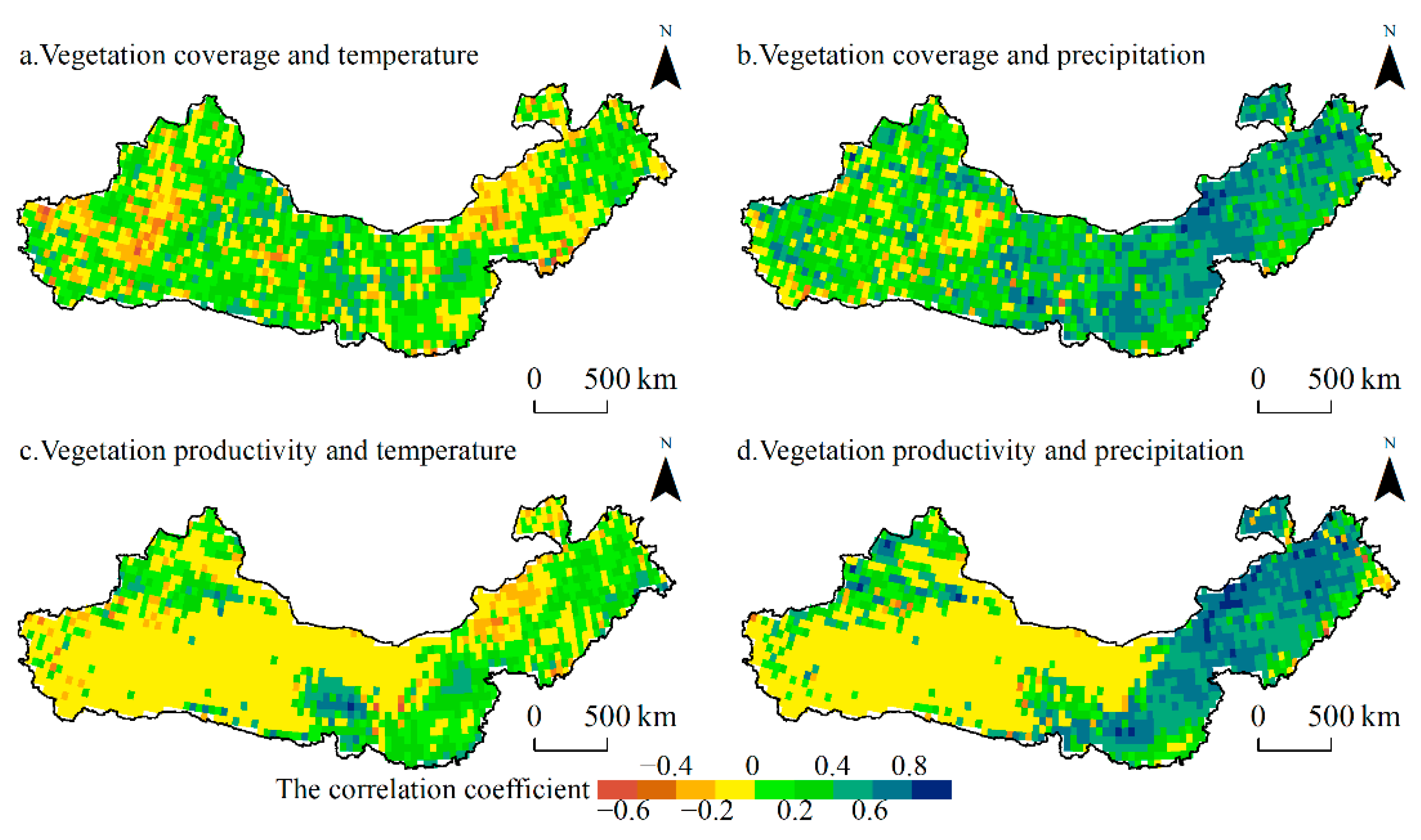

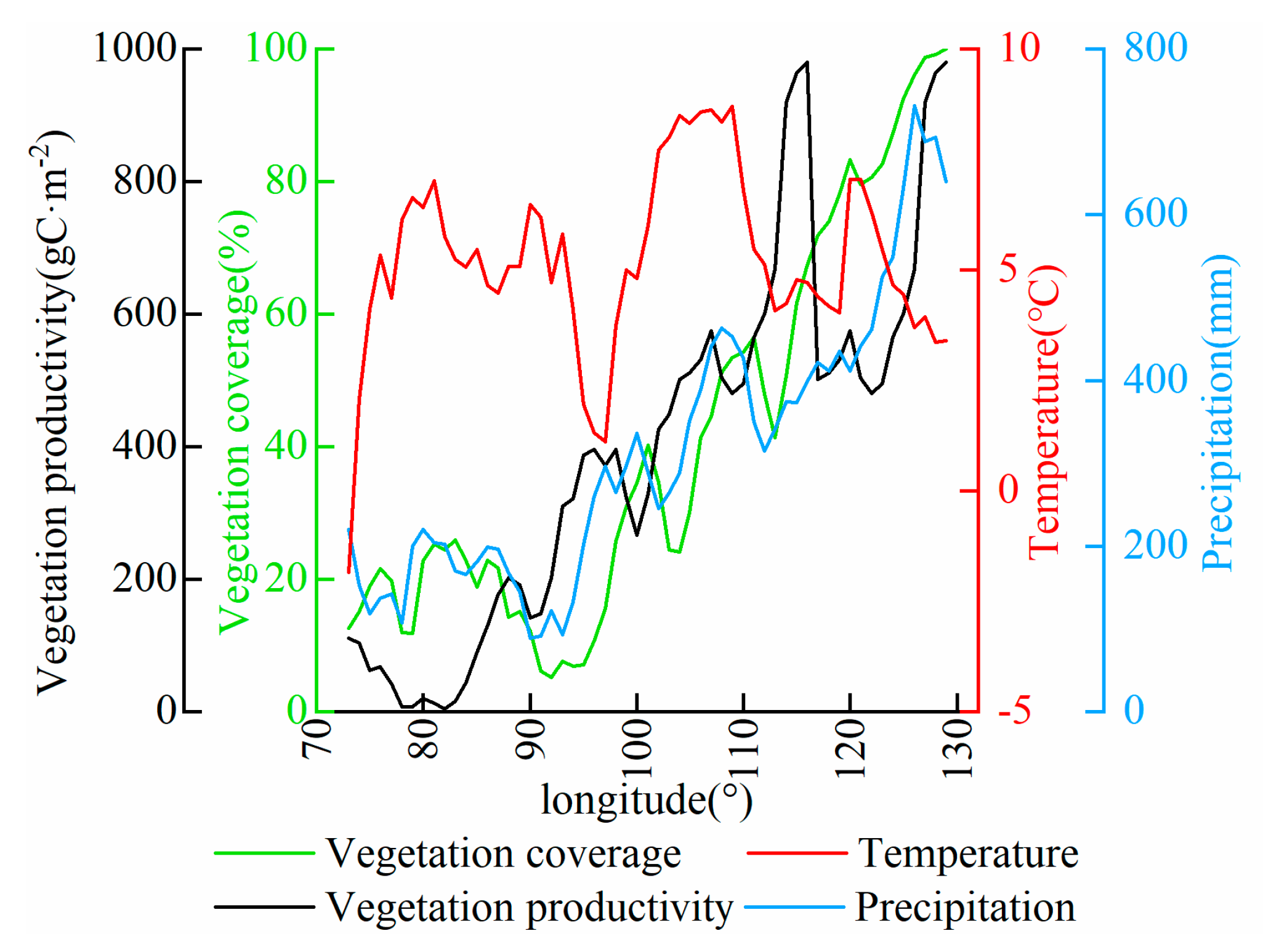
| Code | The Primary Classification | The Secondary Classification and Code |
|---|---|---|
| 1 | cultivated land | croplands (12), cropland/natural vegetation mosaics (14) |
| 2 | forest | evergreen needleleaf forests (1), evergreen broadleaf forests (2), deciduous needleleaf forests (3), deciduous broadleaf forests (4), mixed forest (5), closed shrublands (6), open shrublands (7) |
| 3 | grassland | woody savannas (8), savannas (9), grasslands (10) |
| 4 | water body | permanent wetlands (11), permanent snow and ice (15), water bodies (17) |
| 5 | constructive land | urban and built-up lands (13) |
| 6 | barren | barren (16) |
| Code | AAA | ABB | AAB | ABA | ABC |
|---|---|---|---|---|---|
| Type | No change | Previous change | Later change | Repeated change | Continuous change |
| Coefficient Reference Range | Trend |
|---|---|
| β < 0, |Z| > 1.96 | Significant reduction |
| β < 0, |Z| ≤ 1.96 | Slight reduction |
| β = 0 | Basic stability |
| β > 0, |Z| ≤ 1.96 | Slight increase |
| β > 0, |Z| > 1.96 | Significant increase |
| Type | Area/km2 | Change Rate/% | ||||
|---|---|---|---|---|---|---|
| 2001 | 2010 | 2020 | 2001~2010 | 2010~2020 | 2001~2020 | |
| cultivated land | 408,632 | 428,480 | 465,158 | 4.86 | 8.56 | 13.83 |
| forest | 60,992 | 68,576 | 73,803 | 12.43 | 7.62 | 21.00 |
| grassland | 1,637,223 | 1,648,584 | 1,648,891 | 0.69 | 0.02 | 0.71 |
| water body | 34,259 | 40,942 | 47,936 | 19.50 | 17.08 | 39.92 |
| constructive land | 26,102 | 27,158 | 29,247 | 4.04 | 7.69 | 12.05 |
| barren | 1901,790 | 1,855,261 | 1,803,965 | −2.45 | −2.76 | −5.14 |
Publisher’s Note: MDPI stays neutral with regard to jurisdictional claims in published maps and institutional affiliations. |
© 2022 by the authors. Licensee MDPI, Basel, Switzerland. This article is an open access article distributed under the terms and conditions of the Creative Commons Attribution (CC BY) license (https://creativecommons.org/licenses/by/4.0/).
Share and Cite
Zhang, C.; Yao, X.; Wang, G.; Jin, H.; Sha, T.; Chu, X.; Zhang, J.; Cao, J. Temporal and Spatial Variation of Land Use and Vegetation in the Three–North Shelter Forest Program Area from 2000 to 2020. Sustainability 2022, 14, 16489. https://doi.org/10.3390/su142416489
Zhang C, Yao X, Wang G, Jin H, Sha T, Chu X, Zhang J, Cao J. Temporal and Spatial Variation of Land Use and Vegetation in the Three–North Shelter Forest Program Area from 2000 to 2020. Sustainability. 2022; 14(24):16489. https://doi.org/10.3390/su142416489
Chicago/Turabian StyleZhang, Cong, Xiaojun Yao, Guoyu Wang, Huian Jin, Te Sha, Xinde Chu, Juan Zhang, and Juan Cao. 2022. "Temporal and Spatial Variation of Land Use and Vegetation in the Three–North Shelter Forest Program Area from 2000 to 2020" Sustainability 14, no. 24: 16489. https://doi.org/10.3390/su142416489
APA StyleZhang, C., Yao, X., Wang, G., Jin, H., Sha, T., Chu, X., Zhang, J., & Cao, J. (2022). Temporal and Spatial Variation of Land Use and Vegetation in the Three–North Shelter Forest Program Area from 2000 to 2020. Sustainability, 14(24), 16489. https://doi.org/10.3390/su142416489








